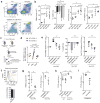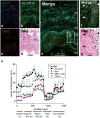Nitric oxide prevents a pathogen-permissive granulocytic inflammation during tuberculosis
- PMID: 28504669
- PMCID: PMC5461879
- DOI: 10.1038/nmicrobiol.2017.72
Nitric oxide prevents a pathogen-permissive granulocytic inflammation during tuberculosis
Abstract
Nitric oxide contributes to protection from tuberculosis. It is generally assumed that this protection is due to direct inhibition of Mycobacterium tuberculosis growth, which prevents subsequent pathological inflammation. In contrast, we report that nitric oxide primarily protects mice by repressing an interleukin-1- and 12/15-lipoxygenase-dependent neutrophil recruitment cascade that promotes bacterial replication. Using M. tuberculosis mutants as indicators of the pathogen's environment, we inferred that granulocytic inflammation generates a nutrient-replete niche that supports M. tuberculosis growth. Parallel clinical studies indicate that a similar inflammatory pathway promotes tuberculosis in patients. The human 12/15-lipoxygenase orthologue, ALOX12, is expressed in cavitary tuberculosis lesions; the abundance of its products correlates with the number of airway neutrophils and bacterial burden and a genetic polymorphism that increases ALOX12 expression is associated with tuberculosis risk. These data suggest that M. tuberculosis exploits neutrophilic inflammation to preferentially replicate at sites of tissue damage that promote contagion.
Figures





Comment in
-
Neutrophils: Double agents for TB.Sci Transl Med. 2017 Jun 14;9(394):eaan6195. doi: 10.1126/scitranslmed.aan6195. Sci Transl Med. 2017. PMID: 28615363
-
Host response: Inflammation promotes TB growth.Nat Microbiol. 2017 Jun 27;2:17102. doi: 10.1038/nmicrobiol.2017.102. Nat Microbiol. 2017. PMID: 28653684 No abstract available.
Similar articles
-
Combination of host susceptibility and virulence of Mycobacterium tuberculosis determines dual role of nitric oxide in the protection and control of inflammation.J Infect Dis. 2009 Apr 15;199(8):1222-32. doi: 10.1086/597421. J Infect Dis. 2009. PMID: 19302011
-
Elevated endothelial nitric oxide bioactivity and resistance to angiotensin-dependent hypertension in 12/15-lipoxygenase knockout mice.Am J Pathol. 2005 Mar;166(3):653-62. doi: 10.1016/S0002-9440(10)62287-0. Am J Pathol. 2005. PMID: 15743778 Free PMC article.
-
Neutrophils: Double agents for TB.Sci Transl Med. 2017 Jun 14;9(394):eaan6195. doi: 10.1126/scitranslmed.aan6195. Sci Transl Med. 2017. PMID: 28615363
-
Why does tuberculosis lead to specific inflammation?Nihon Hansenbyo Gakkai Zasshi. 2009 Sep;78(3):263-9. doi: 10.5025/hansen.78.263. Nihon Hansenbyo Gakkai Zasshi. 2009. PMID: 19803377 Review.
-
PPE2 protein of Mycobacterium tuberculosis may inhibit nitric oxide in activated macrophages.Ann N Y Acad Sci. 2013 Apr;1283:97-101. doi: 10.1111/nyas.12070. Epub 2013 Feb 28. Ann N Y Acad Sci. 2013. PMID: 23448669 Review.
Cited by
-
Rapid lethality of mice lacking the phagocyte oxidase and Caspase1/11 following Mycobacterium tuberculosis infection.bioRxiv [Preprint]. 2023 Feb 11:2023.02.08.527787. doi: 10.1101/2023.02.08.527787. bioRxiv. 2023. Update in: Infect Immun. 2023 Jul 18;91(7):e0006023. doi: 10.1128/iai.00060-23. PMID: 36798180 Free PMC article. Updated. Preprint.
-
Ifnar gene variants influence gut microbial production of palmitoleic acid and host immune responses to tuberculosis.Nat Metab. 2022 Mar;4(3):359-373. doi: 10.1038/s42255-022-00547-3. Epub 2022 Mar 14. Nat Metab. 2022. PMID: 35288721
-
Functionally Overlapping Variants Control Tuberculosis Susceptibility in Collaborative Cross Mice.mBio. 2019 Nov 26;10(6):e02791-19. doi: 10.1128/mBio.02791-19. mBio. 2019. PMID: 31772048 Free PMC article.
-
Lysosomal Cathepsin Release Is Required for NLRP3-Inflammasome Activation by Mycobacterium tuberculosis in Infected Macrophages.Front Immunol. 2018 Jun 21;9:1427. doi: 10.3389/fimmu.2018.01427. eCollection 2018. Front Immunol. 2018. PMID: 29977244 Free PMC article.
-
Host response: Inflammation promotes TB growth.Nat Microbiol. 2017 Jun 27;2:17102. doi: 10.1038/nmicrobiol.2017.102. Nat Microbiol. 2017. PMID: 28653684 No abstract available.
References
-
- Canetti G. The Tubercle Bacillus in the Pulmonary Lesion of Man. The American Journal of the Medical Sciences. 1956;231:480.
MeSH terms
Substances
Grants and funding
LinkOut - more resources
Full Text Sources
Other Literature Sources
Medical

